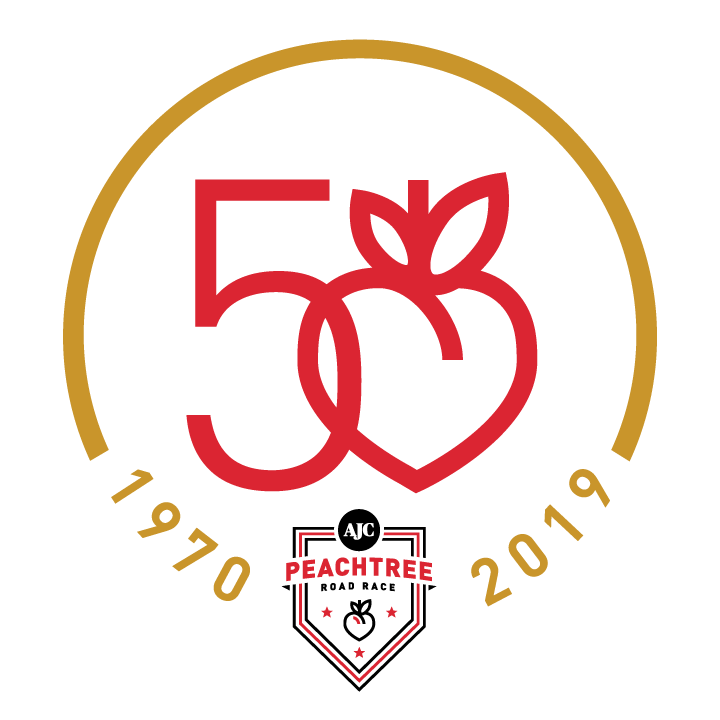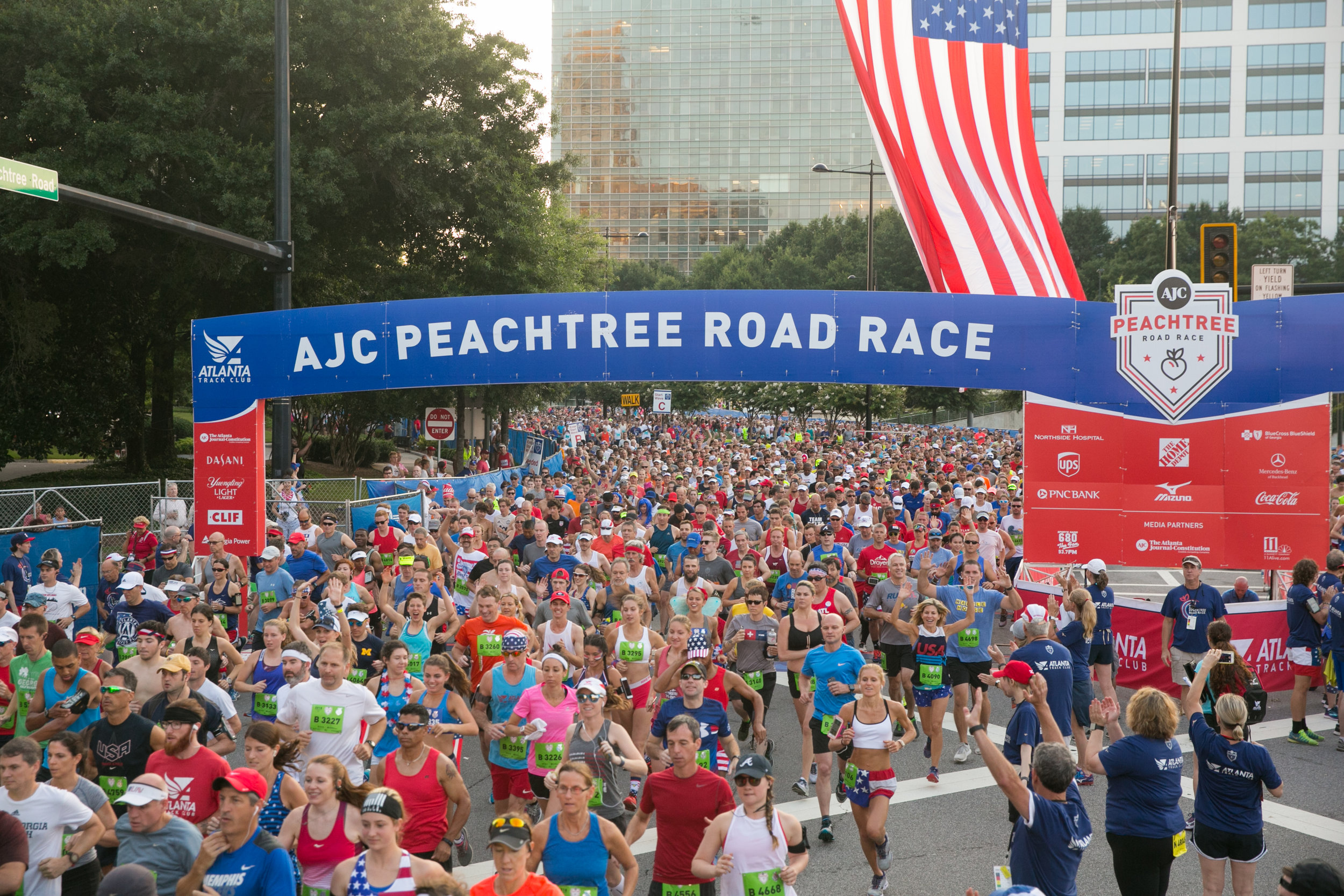24 Hours of Peachtree

It will come as no surprise that July 4 is a busy day for the race director of the AJC Peachtree Road Race. But exactly what is he doing when, and why? Rich Kenah, executive director of Atlanta Track Club and the man in charge of getting 60,000 people safely down Peachtree Road in the iconic event – no pressure! – gives us a glimpse into 24 hours of the 49th Peachtree, his fifth year at the helm. It’s a good bet that the 50th Running won’t be any less hectic.
Midnight – Shortly after waking up at home from a two-hour nap, Kenah drives about 10 minutes to the Lenox Square start line just as the area closes for arrival of the gigantic video board. If the day doesn’t start on time, the cascade effect will be felt for the next 12 hours.
1 a.m. – With the video board under control, Kenah takes advantage of the fleeting calm to drive the course. Jack Abbott, the longtime volunteer course director, has everything well in hand, but it gives Kenah extra peace of mind to see that there are no water main breaks or buildings ablaze. Plus it comforts him to see the finish line at this quiet hour.
2 a.m. – Back at the start line to greet key staff, vendors, security and volunteers as they begin to arrive. There’s “not a ton for me to do” other than make sure everyone stays on schedule, but he knows how important it is to show people they aren’t alone out there in the middle of the night and that he’s there to support them if they need it. C & C Fence Company “drops” – trade lingo for puts up – a few miles of fencing on each side of Peachtree, from the site of the last start wave at Wieuca Road all the way to the Buckhead MARTA station. They’ve been doing it for decades, so it takes them only a few hours. “It’s impressive to watch,” says Kenah. But it’s also hard for him not to jump in, so he picks up a section of fence or hangs a sign himself when he sees the need. The last few dozen port-a-johns are dropped. The sound vendor is setting up. The K-9 security sweeps begin.
4 a.m. – A critical hour, as road closures begin in the assembly area. It’s also when the area becomes secure, meaning that proper credentials granting access are required. The Joint Operations Center and Emergency Operations Center open, and MARTA starts running. TV stations begin jockeying for position in advance of their 6 a.m. broadcasts. The start line truss is rolled into place, and the timing equipment gets installed. This is the hour when the concept of putting on a road race with 60,000 people becomes a reality, and Kenah shifts from just seeing what’s in front of him to staying connected via radios or telephone so he can help solve problems that pop up almost anywhere in the city that might affect the race.
4:30 a.m. – Kenah learns that the off ramp from Route 400 to Lenox Parkway has been closed 45 minutes ahead of schedule, meaning that volunteers who have been given very specific instructions on how to reach their posts are being turned back. He and Kyle Clay, the start line director, hop into a pickup truck and hightail it over to the ramp to get it reopened before the Club faces a problem that could have ripple effects for years. “The more resistance a volunteer encounters, the less likely he or she will get to their post or come back in the future,” he says.
4:45 a.m. – He’s on the move again, this time on the back of a motorcycle to investigate the report of a water main break on Wieuca near Peachtree. False alarm. Soon after comes word of a rumored gas leak. After a quick but thorough investigation by the city, that turns out to be a false alarm, too.
5 a.m. – As first excited participants begin to arrive “and we very quickly find holes, literally and figuratively, in our fencing layout plan,” says Kenah. “It’s a big, coordinated dance, and the left foot needs to know what the right foot is doing. When a piece of fence is put in the wrong place somewhere it might have a domino effect a half mile away. From this point on, I’ll be troubleshooting and problem-solving for pretty much the rest of the day. The difference between a successful year and a less-successful year at an event of this scale is how you handle the problems you encounter, and the key to success in these hours is communication.”
6 a.m. – The Peachtree is now a live event, with longtime announcer Ken Berger – who has also plied his trade at the last few Olympic Games – issuing the first welcome to the sea of incoming runners at precisely 6:06 a.m. 11Alive, the host broadcaster, is on the air from the start line. Whether by car, foot or MARTA, 60,000 people are on the way into what in the past few hours has become one of the most secure areas to be found anywhere “but it’s a weird feeling,” says Kenah, “because standing right on the start line you’re completely oblivious” to the onslaught of humanity converging on Lenox. Before 6 a.m., the pre-race schedule is broken down minute-by-minute; now, it narrows to second-by-second. Are the lead vehicles in place? Are the media vehicles staged and ready to go? Are the motorcycle escorts ready to roll?
6:15 a.m. – Kenah has just finished an interview with 11Alive. He will do maybe half a dozen before the race starts, with local affiliates and the Weather Channel, which is always curious about how the race will deal with the forecast for heat and humidity. The mayor is welcomed.
6:20 a.m. – As the wheelchair racers are directed into place, Kenah assists as needed but “basically, I report to the start line director at this point.”
6:25 a.m. – The first wheelchairs are off.
6:46 a.m. – Mayor Keisha Lance Bottoms addresses the crowd, with Kenah nearby to cue her on when to speak. He does not address the crowd. “When the mayor steps up on the start-line stage and welcomes the people to Atlanta, it feels entirely and completely appropriate that the mayor speak about this event as if it’s the city’s. For all intents and purposes, the mayor IS the race director.”
6:50 a.m. – After the national anthem, the women’s elite race begins.
7 a.m. – Elite men, seeded runners and Wave A get underway. For the next 1 hour and 40 minutes, unless there’s a problem, Kenah is a spectator at what may be the most closely choreographed starting line of any road race in the world, with Clay and his team moving 21 waves of 3000-5000 runners each “as easily as you would walk from your kitchen table to your front door.” But shadowed by a ham radio operator and wearing two more radios himself, in constant communication with an assigned Atlanta Police Department officer, the Emergency Operations Center and the entire race committee., he’s hardly your average fan.
8:35 a.m. – As the last wave gets into place, Kenah – with the ham radio guy and a social media staff person trying to keep up – dashes into the Lenox Square parking lot to jump in his car, strewn with a week’s worth of clothes and 48 hours of half-eaten meals. A police motorcycle, its lights flashing, escorts Kenah via an “eerily quiet” back way to the Park Tavern, just beyond the finish line. There, he jumps out of the car almost before it stops, leaving it to the staff member to find a place to park.
8:45 a.m. – Kenah “swims upstream” from Park Tavern toward the finish line, watching to make sure the finish chute is flowing properly to avoid a human traffic jam that, left unchecked, could back runners up half a mile into the course. He swings by one of the medical tents, the race services trailer and the broadcast booth, then connects with the finish line director to get a report and the timing team to see how many runners have finished so far, allowing him to gauge how many remain on the course. Then it’s back to the main medical tent to assess how many people have been treated before heading to a spot in the middle of the road about 30 meters past the finish line to greet runners after they cross.
9:15 a.m. – Perhaps the best part of Kenah’s day is finding ways to make a connection with the runners. A 50-something man in a Syracuse basketball shirt approaches, so Kenah makes eye contact and a wisecrack about the fierce hardcourt rivalry: “I’m a Georgetown alum; we’re not supposed to talk.” He ends up walking and chatting with the runner for 100 meters before turning around and heading back toward his position, where he easily spots active-duty military and veterans in their special bibs and makes it a point to thank them. Whenever he strikes up a conversation, he keeps walking with the runner, even if it’s just for a few dozen steps, to help keep the traffic flowing.
9:30 a.m. – “You can’t wrap your head around 60,000 people coming across this finish line in such a short time. It’s not like a marathon, where people have 26.2 miles and many hours to spread out. The density is hard to describe – you’ve got to see it.”
11:15 a.m. – The last finisher crosses the line, followed by an army of law enforcement and emergency-services personnel. Kenah follows them down 10th Street to say thank you. Then he heads back to the medical tent for another check-in before doing a few wrap-up media interviews and seeing where things stand with sanitation, shutting down fluid stations and re-opening roads. Atlanta Track Club staff gathers on Charles Allen Drive to immediately begin breaking down the finish line area. The next five or six hours are spent under the hot July sun dismantling everything that had been painstakingly erected over the previous few days. Everyone, Kenah included, chips in.
3 p.m. – As the cleanup winds down, Kenah follows the tradition of previous race directors and goes through the list of race participants transported to area hospitals, then heads off to visit them one by one to see how they’re doing and deliver their T-shirt. The only exception to the Peachtree’s ironclad policy that you have to finish the race to get a shirt, says Kenah, “is when someone has run so hard they put themselves in the hospital.”
7 p.m. – After four hours spent on the road visiting hospitals while constantly checking in with staff and race committee members to handle anything that needs to be done before nightfall, Kenah sits down for a casual, if bleary-eyed, dinner with family and friends.
9:30 p.m. – Kenah has once again failed in his struggle to stay awake for the fireworks. Tomorrow will be a busy day of followup, and “everyone will need to be firing on all cylinders” when they start arriving in the office around 7 a.m. Before the day ends, he will have at least one meeting about the 50th Running.








